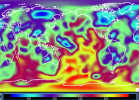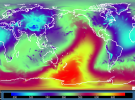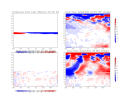The simulation runs fine, but when we activate DART data assimilation some disturbance is excited and transported on the top of the model and the patterns of temperature, winds are degraded.
This happens also if we try to assimilate observations only in the lower troposphere and limit the impact of the observations to remain inside the troposphere (differences between forecast and analysis is zero above the level we set). Seems we produce some gravity waves, maybe.
We can improve the situation only reducing a lot the physical and dynamical time step ATM_NCPL=288 NSPLIT=256
If we turn off Data Assimilation we can recover a smoother field after 20 days.
I've used all the damping flag, second order divergence, fourth order divergence, fourth order divergence and diffusion. Nothing solved the issues. The second order divergence (default ) gave better results.
Does anyone have any ideas of what might be behind this behavior and any ways to control it?
-------------------------------------
The model is CMCC CM3 based on cesm2.1.1-exp17 (69af836c8a857ccac1b36efc04b0008770e5970d) with a different ocean component (NEMO 3.6).
(Unable to provide manage_externals output right now due to inability to access NCAR svn servers)
Code modification is substitution of NEMO for POP which is not relevant for this simulation which is AMIP.
From README.case
2022-04-21 15:18:35: /users_home/csp/gc02720/cesm2_1_intel20_1/cime/scripts/create_clone --case /users_home/csp/gc02720/cesm-exp/conv/conv_0001 --clone /users_home/csp/gc02720/cesm-exp/conv/case_template
---------------------------------------------------
2022-04-21 15:18:35: Compset longname is HIST_CAM60%WCSC_CLM50%SP_CICE%PRES_DOCN%DOM_MOSART_SGLC_SWAV
---------------------------------------------------
2022-04-21 15:18:35: Compset specification file is /users_home/csp/gc02720/cesm2_1_intel20_1/cime/../components/cam//cime_config/config_compsets.xml
---------------------------------------------------
2022-04-21 15:18:35: Pes specification file is /users_home/csp/gc02720/cesm2_1_intel20_1/cime/../components/cam//cime_config/config_pes.xml
---------------------------------------------------
*** original clone README follows ****
2022-04-21 14:58:42: /users_home/csp/gc02720/cesm2_1_intel20_1/cime/scripts/create_newcase --case /users_home/csp/gc02720/cesm-exp/conv/case_template --machine zeus --res f09_f09_mg17 --project R000 --queue p_short --walltime 2:00 --pecount 36x1 --ninst 1 --compset HIST_CAM60%WCSC_CLM50%SP_CICE%PRES_DOCN%DOM_MOSART_SGLC_SWAV --run-unsupported
---------------------------------------------------
2022-04-21 14:58:42: Compset longname is HIST_CAM60%WCSC_CLM50%SP_CICE%PRES_DOCN%DOM_MOSART_SGLC_SWAV
---------------------------------------------------
2022-04-21 14:58:42: Compset specification file is /users_home/csp/gc02720/cesm2_1_intel20_1/components/cam//cime_config/config_compsets.xml
---------------------------------------------------
2022-04-21 14:58:42: Pes specification file is /users_home/csp/gc02720/cesm2_1_intel20_1/components/cam//cime_config/config_pes.xml
---------------------------------------------------
2022-04-21 14:58:42: Forcing is Historic transient
---------------------------------------------------
2022-04-21 14:58:42: Using None coupler instances
---------------------------------------------------
2022-04-21 14:58:42: Component ATM is CAM cam6 physics:WACCM specified chemistry:
---------------------------------------------------
2022-04-21 14:58:42: ATM_GRID is 0.9x1.25
---------------------------------------------------
2022-04-21 14:58:42: Component LND is clm5.0:Satellite phenology:
This information is from one of the clones used in the data assimilation experiment. Only initial conditions are changed. I do not think the compilers or machine are relevant here because the simulation works when not using data assimilation.
This happens also if we try to assimilate observations only in the lower troposphere and limit the impact of the observations to remain inside the troposphere (differences between forecast and analysis is zero above the level we set). Seems we produce some gravity waves, maybe.
We can improve the situation only reducing a lot the physical and dynamical time step ATM_NCPL=288 NSPLIT=256
If we turn off Data Assimilation we can recover a smoother field after 20 days.
I've used all the damping flag, second order divergence, fourth order divergence, fourth order divergence and diffusion. Nothing solved the issues. The second order divergence (default ) gave better results.
Does anyone have any ideas of what might be behind this behavior and any ways to control it?
-------------------------------------
The model is CMCC CM3 based on cesm2.1.1-exp17 (69af836c8a857ccac1b36efc04b0008770e5970d) with a different ocean component (NEMO 3.6).
(Unable to provide manage_externals output right now due to inability to access NCAR svn servers)
Code modification is substitution of NEMO for POP which is not relevant for this simulation which is AMIP.
From README.case
2022-04-21 15:18:35: /users_home/csp/gc02720/cesm2_1_intel20_1/cime/scripts/create_clone --case /users_home/csp/gc02720/cesm-exp/conv/conv_0001 --clone /users_home/csp/gc02720/cesm-exp/conv/case_template
---------------------------------------------------
2022-04-21 15:18:35: Compset longname is HIST_CAM60%WCSC_CLM50%SP_CICE%PRES_DOCN%DOM_MOSART_SGLC_SWAV
---------------------------------------------------
2022-04-21 15:18:35: Compset specification file is /users_home/csp/gc02720/cesm2_1_intel20_1/cime/../components/cam//cime_config/config_compsets.xml
---------------------------------------------------
2022-04-21 15:18:35: Pes specification file is /users_home/csp/gc02720/cesm2_1_intel20_1/cime/../components/cam//cime_config/config_pes.xml
---------------------------------------------------
*** original clone README follows ****
2022-04-21 14:58:42: /users_home/csp/gc02720/cesm2_1_intel20_1/cime/scripts/create_newcase --case /users_home/csp/gc02720/cesm-exp/conv/case_template --machine zeus --res f09_f09_mg17 --project R000 --queue p_short --walltime 2:00 --pecount 36x1 --ninst 1 --compset HIST_CAM60%WCSC_CLM50%SP_CICE%PRES_DOCN%DOM_MOSART_SGLC_SWAV --run-unsupported
---------------------------------------------------
2022-04-21 14:58:42: Compset longname is HIST_CAM60%WCSC_CLM50%SP_CICE%PRES_DOCN%DOM_MOSART_SGLC_SWAV
---------------------------------------------------
2022-04-21 14:58:42: Compset specification file is /users_home/csp/gc02720/cesm2_1_intel20_1/components/cam//cime_config/config_compsets.xml
---------------------------------------------------
2022-04-21 14:58:42: Pes specification file is /users_home/csp/gc02720/cesm2_1_intel20_1/components/cam//cime_config/config_pes.xml
---------------------------------------------------
2022-04-21 14:58:42: Forcing is Historic transient
---------------------------------------------------
2022-04-21 14:58:42: Using None coupler instances
---------------------------------------------------
2022-04-21 14:58:42: Component ATM is CAM cam6 physics:WACCM specified chemistry:
---------------------------------------------------
2022-04-21 14:58:42: ATM_GRID is 0.9x1.25
---------------------------------------------------
2022-04-21 14:58:42: Component LND is clm5.0:Satellite phenology:
This information is from one of the clones used in the data assimilation experiment. Only initial conditions are changed. I do not think the compilers or machine are relevant here because the simulation works when not using data assimilation.



